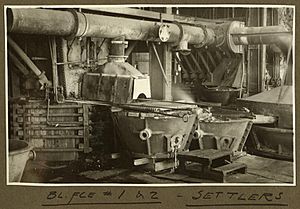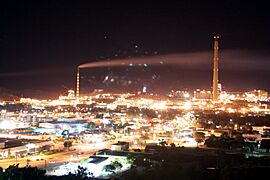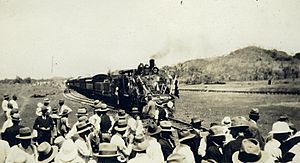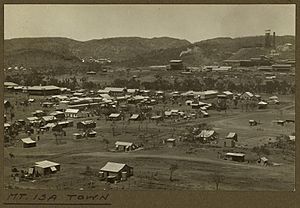Mount Isa facts for kids
Quick facts for kids Mount IsaQueensland |
|||||||||
|---|---|---|---|---|---|---|---|---|---|
|
Top to bottom, left to right: Mount Isa panorama; Lake Moondarra; The Sign, Mount Isa Mines stack, Mount Isa City; Mount Isa at night
|
|||||||||
| Population | 18,317 (2021 census) | ||||||||
| • Density | 266.62/km2 (690.5/sq mi) | ||||||||
| Established | 1923 | ||||||||
| Postcode(s) | 4825 | ||||||||
| Elevation | 356 m (1,168 ft) | ||||||||
| Area | 68.7 km2 (26.5 sq mi) | ||||||||
| Time zone | AEST (UTC+10:00) | ||||||||
| Location |
|
||||||||
| LGA(s) | City of Mount Isa | ||||||||
| State electorate(s) | Traeger | ||||||||
| Federal Division(s) | Kennedy | ||||||||
|
|||||||||
Mount Isa (/ˈaɪzə/ EYE-zə) is a city in Queensland, Australia. It's often called "The Isa" by locals. The city grew because of the huge amounts of minerals found there. Mount Isa Mines (MIM) is one of the world's most successful mines. It has produced a lot of lead, silver, copper, and zinc.
Long ago, before Europeans arrived, the Mount Isa area was part of a big trade network. This network stretched across the entire Lake Eyre basin. The local people valued this area for its stone, which they used to make tools like hand axes.
In 2021 census, Mount Isa had a population of 18,317 people. This makes it an important centre for business and industry in Queensland's north-west. Even though it's in a dry area, Lake Moondarra provides drinking water. This artificial lake is about 19 kilometres (12 mi) north of the city on the Leichhardt River. It's also a great spot for watersports, birdwatching, and other fun activities.
Because of the lead mining, Mount Isa has a special system to check air quality. This helps make sure everyone stays healthy.
Contents
- About Mount Isa's Location
- Mount Isa's Past
- People of Mount Isa
- Important Places and Buildings
- How Mount Isa is Governed
- Mount Isa's Economy
- Learning in Mount Isa
- Water Supply
- Fun Things to Do
- Places to Visit
- Major Events
- Getting Around Mount Isa
- Media in Mount Isa
- Mount Isa's Weather
- Famous People from Mount Isa
- See also
About Mount Isa's Location
The Leichhardt River flows through Mount Isa. It divides the city into two main parts: "mineside" and "townside." The mining company Xstrata, the power station, and the airport are on the mineside. Most of the city, including the main shopping area and the hospital, is on the townside.
In recent years, more people have moved to Mount Isa because of the mining boom. This has led to new homes and suburbs being built. The city is growing, with plans to make room for more than 40,000 people.
Here are some of Mount Isa's suburbs:
- Happy Valley – Home to Happy Valley State School and St Joseph's Catholic Primary School.
- Kalkadoon – Where you'll find Mount Isa Airport.
- Mica Creek – Location of the CS Energy Mica Creek Power Station.
- Miles End – Includes the Mount Isa Civic Centre and the railway station.
- Parkside – Mount Isa's biggest and oldest suburb.
- Soldiers Hill – Streets and parks here are named after war places and soldiers.
- Hilton – Also known as Mineside, this area is west of the railway line. It's where Mount Isa Mines is located. It also has Casa Grande, a mansion built for Queen Elizabeth II's visit.
Other suburbs include:
- Breakaway – Has larger, semi-rural properties.
- Fisher
- Healy – A residential area with Healy State School.
- Lanskey
- Menzies – Includes the Buchanan Park events complex and racecourse.
- Mornington
- Mount Isa City – This is the main business district.
- Mount Isa East – Has its own post office and smaller shops.
- Pioneer – Home to a campus of TAFE Queensland North and Spinifex State College Senior Campus.
- Ryan – Mostly industrial, with army and State Emergency Service barracks.
- Spreadborough – Mostly bushland and light industry.
- Sunset – Home to Sunset State Primary School and some shops.
- The Gap
- Townview – Home to Townview State Primary School.
- Winston
Mount Isa's Past

The land where Mount Isa now stands was originally home to the Kalkatungu Aboriginal tribe. They lived off the land, which settlers saw as only good for grazing animals. As more settlers and gold seekers moved in, the Kalkadoon tribe fought to protect their land. They were very successful in their guerrilla warfare.
However, in 1884, at Battle Mountain, the tribe attacked a strong position and suffered heavy losses. This weakened them, and they lost much of their land. The following decades were tough for the tribe and for the settlers trying to farm the dry land.
The discovery of Mount Isa's rich minerals is often credited to a lone prospector named John Campbell Miles in 1923. However, many people don't know that a young Aboriginal man named Kabalulumana led him to the deposits. When Miles saw the yellow-black rocks, they reminded him of ore from the Broken Hill mine where he used to work. He sent a sample to be tested, and it confirmed their great value.
Miles and four farmers claimed the first mining spots. Miles named his new claim "Mount Isa" after the Mount Ida Gold Mine in Western Australia, which his friends had told him about.
The Mount Isa Post Office opened on 1 August 1924. The town's hospital site was chosen in 1929. A larger hospital building was moved there in 1931 from a closed mining town called Kuridala.
People of Mount Isa
In 2021 census, Mount Isa had a population of 18,317 people. The number of males and females in the city is quite balanced. In 2011 census, 52.8% of residents were male and 47.2% were female.
Important Places and Buildings
Mount Isa has several sites listed for their historical importance. These "heritage-listed" sites include:
- Underground Hospital, Camooweal Street
- Tent House, Camooweal Street
- Spinifex State College Junior Campus, 6–12 Fifth Avenue
- Bower Bird Battery, Mount Isa Mining District
- Mount Isa Mine Early Infrastructure, Mount Isa Mine Lease
- Casa Grande, Nettle Street
How Mount Isa is Governed
Mount Isa is part of the City of Mount Isa local government area. At the state level, it's in the electoral district of Traeger. For federal elections, it's part of the Division of Kennedy.
The mayor of Mount Isa, as of the 2020 elections, is Danielle Slade. The City of Mount Isa local government area is very large, covering 43,188 square kilometres. It's the second largest in Australia by area. This area includes the town of Camooweal, about 188 km (117 mi) north-west of Mount Isa.
Mount Isa's Economy
Mount Isa's economy mostly relies on mining. Glencore runs the Mount Isa Mines, which is right next to the city. This includes the "Enterprise" and X41 underground copper mines. It also has the "Black Star Open Cut" silver-lead-zinc mine.
Silver-lead-zinc ore is also mined at Hilton, about 20 km (12 mi) north of Mount Isa. This ore is then trucked back to Mount Isa for processing. Mount Isa is one of the top two largest copper mining and smelting operations in Australia.
Copper and lead are processed right there in Mount Isa. The copper and zinc are then sent 900 km (560 mi) to Townsville on the east coast. The lead is sent to a refinery in Britain to extract the silver. The mine's tall stack, built in 1978, is 270 metres high. You can see it from all over the city and even up to 40 km (25 mi) away!
Learning in Mount Isa
Mount Isa has many schools for young people. There are eight public primary schools and three private primary schools:
- Happy Valley State School
- Healy State School
- Townview State School
- Barkly Highway State School
- Central State School
- Sunset State School
- Mount Isa School of the Air
- Mount Isa Special School
- St Kieren's (private)
- St Josephs (private)
There are also four high schools:
- Good Shepherd Catholic College (private)
- Mt Isa Flexible Learning Centre (private)
- Mount Isa School of the Air (up to Grade 10)
- Spinifex State College – This college has three campuses. The Junior campus is for Grades 7 to 9. The Senior campus is for Grades 10 to 12. There's also a Residential campus for students who live in remote areas and need a place to stay.
Mount Isa is also home to the School of the Air. This unique Australian school teaches students who live in very remote areas using radio and online lessons. The city also has the main campus of the Mount Isa Institute of TAFE. TAFE offers courses in many areas, like mining, agriculture, and trades. James Cook University also has a presence here, with a centre for rural and remote health.
Water Supply
Mount Isa gets its water from two lakes: Lake Moondarra, which is 13 km (8.1 mi) away, and Lake Julius, 60 km (37 mi) away. It costs more to get water from Lake Julius, so water usually comes from Lake Moondarra. However, during dry periods, water must be taken from Lake Julius. The biggest users of water are Mount Isa Mines, Incitec Pivot, and the Mount Isa City Council. The council supplies water to homes and smaller businesses.
Because of a long dry spell, water levels in Lake Moondarra have been very low. This has led to water restrictions in the town. If water levels get too low, boating on Lake Moondarra might be limited for safety. Fish in the lake could also be at risk if the water drops too much.
Water is usually cleaned using a natural process with reed beds. But the long dry weather has caused blue-green algae to grow in the lakes. This means a special filtration plant is needed to remove the algae.
Fun Things to Do
The City of Mount Isa has a public library on West Street. It has a fast internet connection. Mount Isa also has a cinema complex with three air-conditioned movie theatres. There's a skate park, an aquatic centre, and a sports complex for basketball and other indoor games.
Buchanan Park, an events complex, opened in 2007. It can hold up to 6,000 people. It's used for concerts, expos, and the city's yearly show and rodeo.
The city is famous for its annual Rodeo and Mardi Gras street parade, held every August. There's also a Multicultural Festival in early September. The local theatre group, MITS, often puts on plays and musicals.
Many sports are popular in Mount Isa, including athletics, gymnastics, tennis, rugby league, field hockey, football, netball, cricket, and Australian rules football. You can also find shooting, squash, softball, basketball, BMX racing, and ten-pin bowling. Mount Isa has a Go Kart Club too.
Places to Visit
One popular attraction is the Hard Times Mine at "Outback at Isa." The Mount Isa Rodeo and Mardi Gras, held on the same weekend, have given Mount Isa the nickname "Rodeo Capital of Australia." This event can triple the city's population for a few days! There's a special memorial for the Rodeo on Rodeo Drive.
The burial place of John Campbell Miles, who founded Mount Isa, is at the corner of Rodeo Drive and Miles Street. His ashes are buried under a large statue. Each part of the statue shows something important about Mount Isa.
The World War II-era Mount Isa Underground Hospital is a historic building. It was an air-raid shelter that could also work as a hospital. It was built as a safety measure after Darwin was bombed in 1942. Local miners dug out the site. It's the only underground health facility in Queensland built during World War II.
Major Events
The Mount Isa Rodeo has been held every year since 1959. Besides the rodeo itself, there are street parties, music, market stalls, and family fun. The Rodeo Queen Quest raises money for charities. The Rodeo Queen is crowned at the Rodeo Ball. You can even go to a rodeo school if you want to learn bull riding! It's the biggest annual rodeo in the Southern Hemisphere.
The Mount Isa parkrun is a 5 km run held every Saturday at 7 am. It's free and starts at Tharrapatha Way. It began in 2018 and attracts runners of all levels.
The Glencore Mount Isa Lake Moondarra Fishing Classic is held every year. It's the richest freshwater fishing event in Queensland. Catching a tagged barramundi can win you a big prize!
Getting Around Mount Isa
Mount Isa has a taxi service with 35 vehicles. There's also a taxi service called "Isa-Curry" express that takes people to and from Cloncurry for shopping or medical needs. Many clubs in the city have courtesy buses that run late into the night. Mount Isa Coaches offers tours and transport for mining, sports, schools, and airport transfers. Greyhound Australia has a stop in Mount Isa, with bus services to Townsville, Brisbane, and Tennant Creek.
Mount Isa Airport has daily flights to Brisbane, Cairns, and Townsville. It also has flights to other remote towns in western Queensland. The main airlines are Qantas/QantasLink, AirNorth, and Regional Express. Virgin Australia also offers flights to Brisbane on weekdays.
The city is served by the QR passenger train The Inlander. This train travels overnight to Townsville twice a week in each direction.
| Preceding station | Queensland Rail | Following station | ||
|---|---|---|---|---|
| Long distance rail services | ||||
| Duchess
towards Townsville
|
The Inlander | Terminus | ||
Media in Mount Isa
Radio Stations
You can listen to these radio stations in Mount Isa:
- AM 666 4LM (commercial)
- FM 87.6 Vision Radio (religious)
- FM 88.0 Faith FM (religious)
- FM 100.9 Mob FM (commercial)
- FM 101.7 ABC Classic
- FM 102.5 Hit FM (commercial)
- FM 103.3 TAB Radio (horse racing)
- FM 104.1 ABC Triple J
- FM 104.9 ABC News Radio
- FM 105.7 Rhema FM (religious)
- FM 106.1 SBS Radio
- FM 106.5 ABC North West
- FM 107.1 ABC Radio National
Television
Mount Isa has five main TV channels:
- Central Digital Television (a Network Ten channel)
- Imparja Television (a Nine Network channel)
- Southern Cross Seven (a Seven Network channel)
- The government-owned ABC
- SBS
You can also watch Aboriginal-focused channels NITV and ICTV. Digital TV broadcasts have started in Mount Isa, offering more channels.
Newspapers
The North West Star is a local newspaper printed three times a week. You can also buy The Courier-Mail, The Sunday Mail, and the Townsville Bulletin.
Mount Isa's Weather
Mount Isa has a hot semi-arid climate. This means it's usually hot and dry. The summer, or wet season, is very hot with changing rainfall and humidity. This is due to the monsoon season, which can be very strong or almost non-existent. A typical summer has many hot, windy days over 40 °C. There are also weeks with temperatures between 35-40 °C, higher humidity, and exciting thunderstorms. Sometimes, there are a few days with heavy monsoon rain and cooler temperatures below 30 °C.
The winter, or dry season, is warm and almost completely without rain. From April to September, the average monthly rainfall is very low. Nights can be quite cool, and about once every three years, the temperature drops below 0 °C (32 °F). Rarely, winter rain systems can bring heavy rain for a day or two.
The lowest temperature ever recorded in Mount Isa was −2.9 °C (26.8 °F) on 7 July 1984. The hottest was 45.9 °C (114.6 °F) on 29 January 1990. The most rain in 24 hours was 213.0 mm (8.39 in) on 15 January 2004.
| Climate data for Mount Isa | |||||||||||||
|---|---|---|---|---|---|---|---|---|---|---|---|---|---|
| Month | Jan | Feb | Mar | Apr | May | Jun | Jul | Aug | Sep | Oct | Nov | Dec | Year |
| Record high °C (°F) | 45.9 (114.6) |
43.5 (110.3) |
41.9 (107.4) |
38.6 (101.5) |
37.8 (100.0) |
34.3 (93.7) |
35.2 (95.4) |
36.4 (97.5) |
39.5 (103.1) |
42.5 (108.5) |
43.9 (111.0) |
45.1 (113.2) |
45.9 (114.6) |
| Mean daily maximum °C (°F) | 36.4 (97.5) |
35.4 (95.7) |
34.4 (93.9) |
32.0 (89.6) |
27.9 (82.2) |
24.9 (76.8) |
24.8 (76.6) |
27.3 (81.1) |
31.3 (88.3) |
34.7 (94.5) |
36.5 (97.7) |
37.1 (98.8) |
31.9 (89.4) |
| Mean daily minimum °C (°F) | 23.7 (74.7) |
23.3 (73.9) |
21.8 (71.2) |
18.5 (65.3) |
13.9 (57.0) |
10.0 (50.0) |
8.7 (47.7) |
10.2 (50.4) |
14.2 (57.6) |
18.5 (65.3) |
21.5 (70.7) |
23.1 (73.6) |
17.3 (63.1) |
| Record low °C (°F) | 15.4 (59.7) |
13.1 (55.6) |
13.1 (55.6) |
6.2 (43.2) |
1.8 (35.2) |
−1.3 (29.7) |
−2.9 (26.8) |
−1.1 (30.0) |
1.0 (33.8) |
6.1 (43.0) |
10.3 (50.5) |
13.4 (56.1) |
−2.9 (26.8) |
| Average rainfall mm (inches) | 117.4 (4.62) |
100.8 (3.97) |
63.2 (2.49) |
14.4 (0.57) |
12.6 (0.50) |
6.5 (0.26) |
6.0 (0.24) |
3.5 (0.14) |
8.5 (0.33) |
17.9 (0.70) |
38.0 (1.50) |
74.0 (2.91) |
462.8 (18.23) |
| Average rainy days (≥ 1 mm) | 7.8 | 7.2 | 4.0 | 1.4 | 1.2 | 0.7 | 0.6 | 0.6 | 0.9 | 2.3 | 4.0 | 5.9 | 36.6 |
| Average relative humidity (%) | 35 | 38 | 32 | 27 | 29 | 28 | 25 | 20 | 18 | 18 | 22 | 27 | 27 |
| Source: Australian Bureau of Meteorology | |||||||||||||
Famous People from Mount Isa
Many well-known people have connections to Mount Isa, including:
- William Barton (musician) – A famous musician.
- Simon Black – An Australian rules footballer.
- Charlie Cameron – Another Australian rules footballer.
- Lindy Chamberlain – Her baby, Azaria, was born in Mount Isa.
- Altiyan Childs – Winner of The X Factor (Australia season 2).
- Peter Crawford – A basketball player.
- Gerard Denton – A cricketer.
- Karen Foxlee – A novelist.
- Greg Norman – A famous golfer.
- Kalyn Ponga – A rugby league player.
- Scott Prince – A rugby league player.
- Pat Rafter – A well-known tennis player.
- Bill Sweetenham – An Olympic swimming coach.
- Carl Webb – A rugby league player.
- John White – A squash player.
See also
 In Spanish: Mount Isa para niños
In Spanish: Mount Isa para niños














